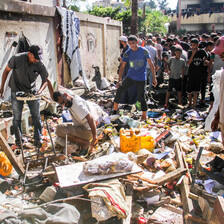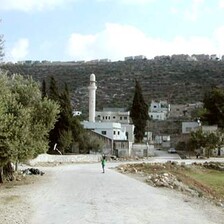The Electronic Intifada 3 February 2009
RAMALLAH, occupied West Bank (IPS) - As fears rise of renewed violence in Gaza, Elena Qleibo, a French-Costa Rican aid worker from Oxfam, gives IPS a first-hand account of surviving Israel’s three-week bombardment of Gaza.
Excerpts from her account:
I was attending a meeting at Gaza City municipality on 27 December when suddenly the meeting was interrupted by heavy booming sounds coming from a short distance away.
Plumes of smoke were rising from a number of bombed areas surrounding the building I was in. I and a number of colleagues rushed outside to try and establish what was happening.
Mayhem and confusion reigned as shocked Gazans realized they were coming under a sustained attack from warships off the coast and aerial bombardments from fighter jets circling the skies above. Later on as I tried to gather more information from people in my neighborhood, many appeared in a state of incomprehension at the ferocity of the assault.
I am a cultural anthropologist, and first decided to make Gaza City my home in 2004 after living and working in the occupied Palestinian territories for a number of years. My first visit to Gaza was in 1987 during the first Palestinian uprising, or intifada.
During my years in Gaza I witnessed a lot of violence and upheaval during previous Israeli military attacks but never before had I seen devastation on this scale.
When Hamas took over Gaza in July 2007, I was forced to spend many nights on my apartment floor as gunfights erupted in the streets below, but the bloodshed and destruction was a fraction of what I recently witnessed.
During the early days of the campaign, I was dreadfully worried about the people who would inevitably be killed and maimed as I watched the bombs raining down around me on densely populated neighborhoods.
As the nightmarish days of Israel’s military operation turned into weeks, I tried to spend a fair amount of time in my apartment and only ventured outdoors during the daily three-hour lull period in order to try and coordinate the delivery of emergency food and aid packages to the wounded, starving and dying Gazans who were trapped in their homes.
Sometimes I wasn’t sure which was safer, remaining indoors to avoid being bombed in the streets or leaving my apartment to seek shelter elsewhere in the event my building was bombed.
One day as I was looking out my apartment window I saw fast moving plumes of what at first appeared to be smoke coming from Israeli planes in the skies over Gaza City. At first I thought they might be tear gas but then realized this was very unlikely as the trails were coming down way too quickly.
As the “smoke” blew my way it had a very acrid and rancid smell, I then realized it might be a chemical weapon which could cause serious injuries. I quickly closed my windows and curtains and hid in the inner rooms of my apartment. Fortunately the wind then blew the fumes away. I later found out that these were phosphorous bombs.
The scale of devastation and destruction became evident towards the end of Israel’s military assault, codenamed Operation Cast Lead. During the first days of the ceasefire, my mind wandered back to my first visit in Gaza when I had been overwhelmed at the beauty and potential of the place.
It was summer 1987 and I had just returned from a refreshing morning swim in a turquoise, clean sea lapping on a deserted powdery beach. I picked some white sea lilies before joining a family of close friends for a delicious breakfast of fresh green figs.
The family began to prepare lunch, which we later ate in the orchard. Gaza was full of fruit trees back then. One of the most poignant memories I have is the almost suffocating fragrance of orchards of orange blossoms when I first passed through Beit Hanoun, in northern Gaza, on my way to Gaza city.
As I look at what remains of Gaza now an apocalypse would describe the situation accurately. Much of Beit Hanoun’s trees, orchards and greenery had already been leveled or uprooted during previous Israeli incursions. But now the foliage and orchards are only a memory.
People are mostly exhausted and bereft of hope. But the head of one agricultural association that I visited voiced cautious optimism that he might be able to export two million flower buds that were stored in refrigerators and had miraculously survived destruction.
I traveled to Beit Lahiya, also in northern Gaza, recently to visit some of Oxfam’s beneficiaries. The strawberry fields, chicken farms and cow pastures were gone. The stench of dead and decaying animals was choking.
Amongst the mountains of rubble that remained of homes, flattened either by F-16s or Merkava tanks, people were gingerly picking their way through, trying to salvage a few family items and attempting to clean away the debris.
Other residents were too numb to do anything, and just sat around in groups drinking tea. Even the dogs looked stunned, and instead of barking at us as they usually do when we pass, they just stared at us.
The worst hit areas appeared in one area of Jabaliya refugee camp on the outskirts of Gaza City. It used to be a nice neighborhood with double-storey homes and neatly paved roads. Two houses remain. Some people sat in tents while others sat on what remained of their homes.
Approximately 50,000 Gazans were displaced during the fighting. The UN agency for Palestine refugees (UNRWA) told me several days ago that about 14,000 people had tried to return home only to find there was nothing to return to.
These people are staying in temporary shelters as UNRWA and the World Food Programme (WFP) tries to bring a semblance of normality back to their shattered lives by providing temporary shelter, food and water. Schools that were damaged are being repainted and rebuilt in a bid to provide a less traumatic environment for children.
The destruction is overwhelming to the point where it is sometimes hard to know where to begin after basic necessities have been provided.
Aid is slowly coming in but a lot more is needed. I feel very grim about the future. There are so many people, breadwinners in particular, who are amputees and seriously maimed. They will forever be aid-dependent and unable to live normal lives or support their families.
All rights reserved, IPS - Inter Press Service (2009). Total or partial publication, retransmission or sale forbidden.
Related Links





